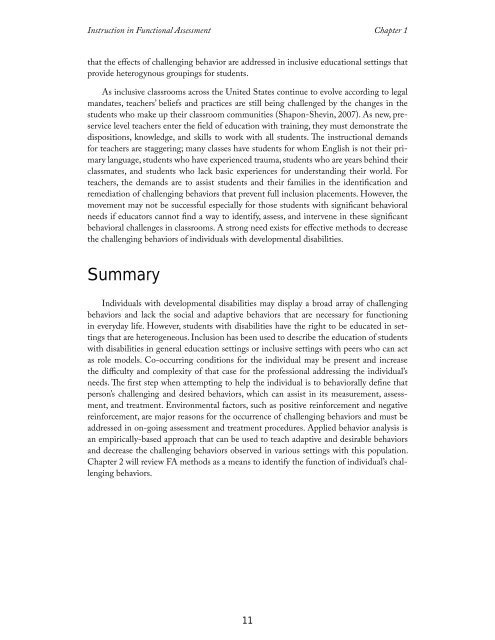Instruction in Functional Assessment, 2014a
Instruction in Functional Assessment, 2014a
Instruction in Functional Assessment, 2014a
You also want an ePaper? Increase the reach of your titles
YUMPU automatically turns print PDFs into web optimized ePapers that Google loves.
<strong>Instruction</strong> <strong>in</strong> <strong>Functional</strong> <strong>Assessment</strong> Chapter 1<br />
that the effects of challeng<strong>in</strong>g behavior are addressed <strong>in</strong> <strong>in</strong>clusive educational sett<strong>in</strong>gs that<br />
provide heterogynous group<strong>in</strong>gs for students.<br />
As <strong>in</strong>clusive classrooms across the United States cont<strong>in</strong>ue to evolve accord<strong>in</strong>g to legal<br />
mandates, teachers’ beliefs and practices are still be<strong>in</strong>g challenged by the changes <strong>in</strong> the<br />
students who make up their classroom communities (Shapon-Shev<strong>in</strong>, 2007). As new, preservice<br />
level teachers enter the field of education with tra<strong>in</strong><strong>in</strong>g, they must demonstrate the<br />
dispositions, knowledge, and skills to work with all students. The <strong>in</strong>structional demands<br />
for teachers are stagger<strong>in</strong>g; many classes have students for whom English is not their primary<br />
language, students who have experienced trauma, students who are years beh<strong>in</strong>d their<br />
classmates, and students who lack basic experiences for understand<strong>in</strong>g their world. For<br />
teachers, the demands are to assist students and their families <strong>in</strong> the identification and<br />
remediation of challeng<strong>in</strong>g behaviors that prevent full <strong>in</strong>clusion placements. However, the<br />
movement may not be successful especially for those students with significant behavioral<br />
needs if educators cannot f<strong>in</strong>d a way to identify, assess, and <strong>in</strong>tervene <strong>in</strong> these significant<br />
behavioral challenges <strong>in</strong> classrooms. A strong need exists for effective methods to decrease<br />
the challeng<strong>in</strong>g behaviors of <strong>in</strong>dividuals with developmental disabilities.<br />
Summary<br />
Individuals with developmental disabilities may display a broad array of challeng<strong>in</strong>g<br />
behaviors and lack the social and adaptive behaviors that are necessary for function<strong>in</strong>g<br />
<strong>in</strong> everyday life. However, students with disabilities have the right to be educated <strong>in</strong> sett<strong>in</strong>gs<br />
that are heterogeneous. Inclusion has been used to describe the education of students<br />
with disabilities <strong>in</strong> general education sett<strong>in</strong>gs or <strong>in</strong>clusive sett<strong>in</strong>gs with peers who can act<br />
as role models. Co-occurr<strong>in</strong>g conditions for the <strong>in</strong>dividual may be present and <strong>in</strong>crease<br />
the difficulty and complexity of that case for the professional address<strong>in</strong>g the <strong>in</strong>dividual’s<br />
needs. The first step when attempt<strong>in</strong>g to help the <strong>in</strong>dividual is to behaviorally def<strong>in</strong>e that<br />
person’s challeng<strong>in</strong>g and desired behaviors, which can assist <strong>in</strong> its measurement, assessment,<br />
and treatment. Environmental factors, such as positive re<strong>in</strong>forcement and negative<br />
re<strong>in</strong>forcement, are major reasons for the occurrence of challeng<strong>in</strong>g behaviors and must be<br />
addressed <strong>in</strong> on-go<strong>in</strong>g assessment and treatment procedures. Applied behavior analysis is<br />
an empirically-based approach that can be used to teach adaptive and desirable behaviors<br />
and decrease the challeng<strong>in</strong>g behaviors observed <strong>in</strong> various sett<strong>in</strong>gs with this population.<br />
Chapter 2 will review FA methods as a means to identify the function of <strong>in</strong>dividual’s challeng<strong>in</strong>g<br />
behaviors.<br />
11


















